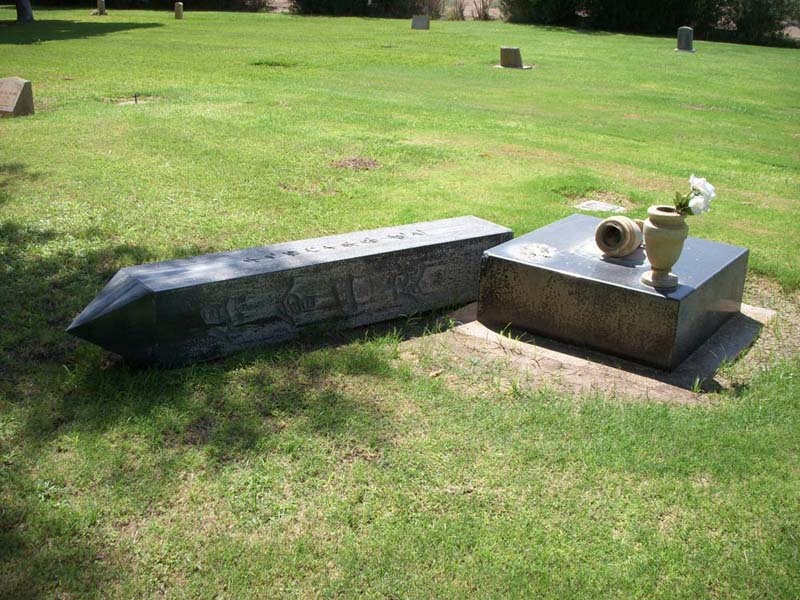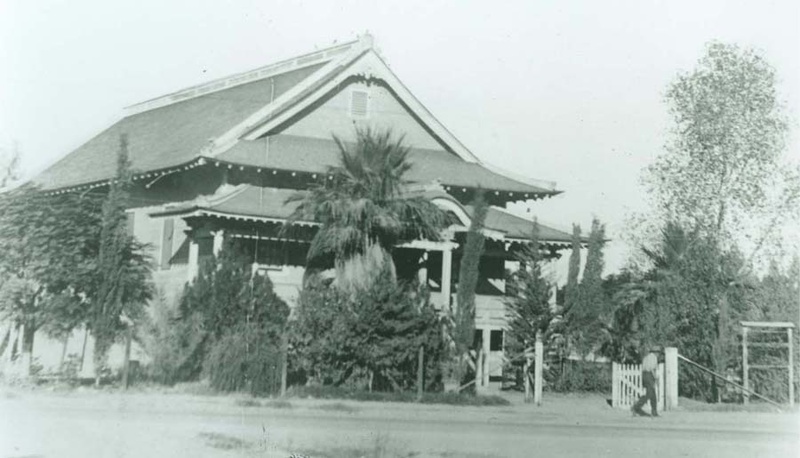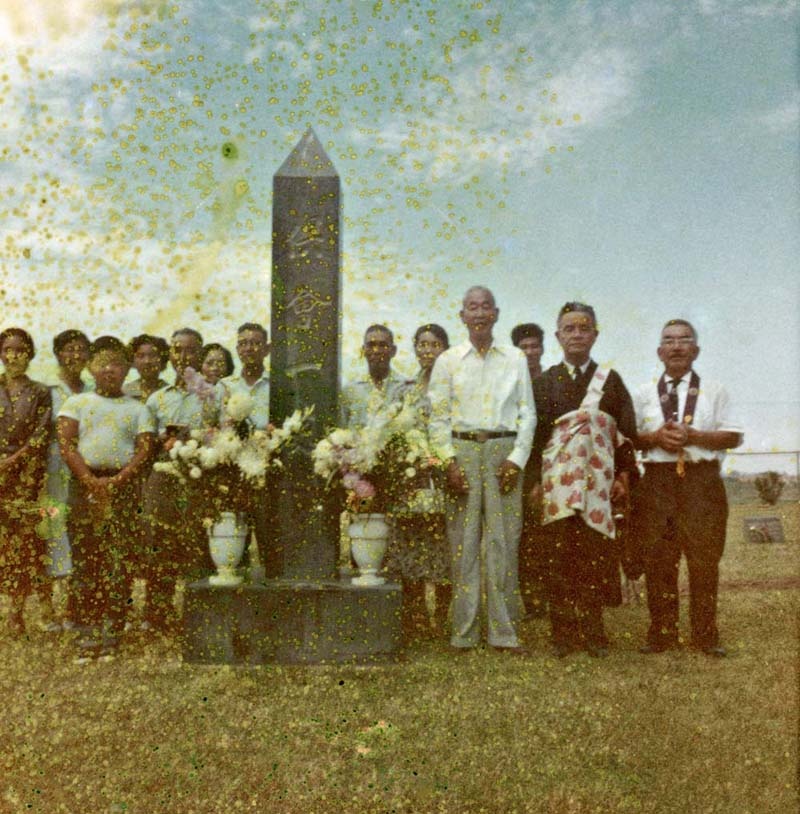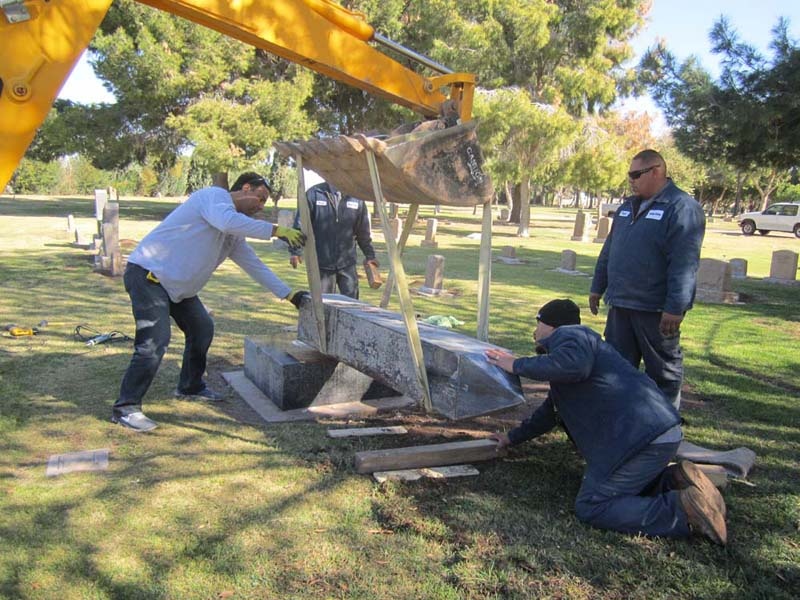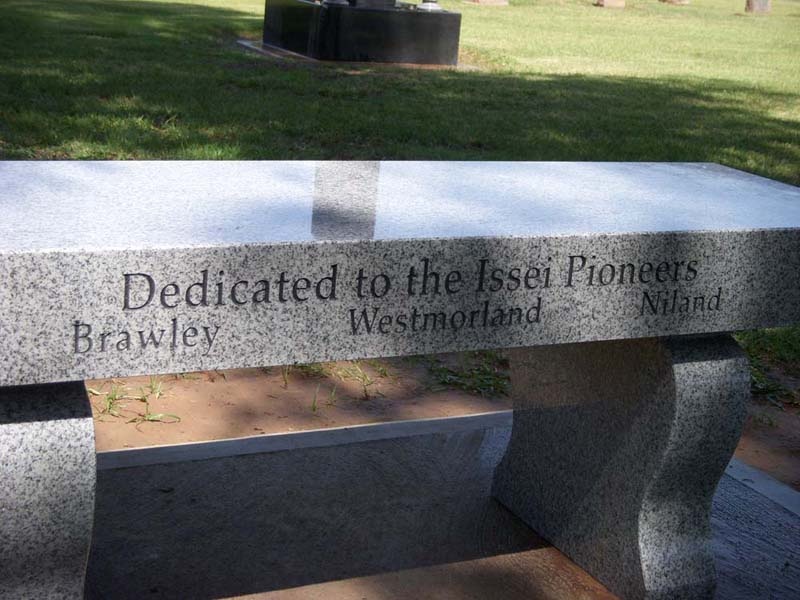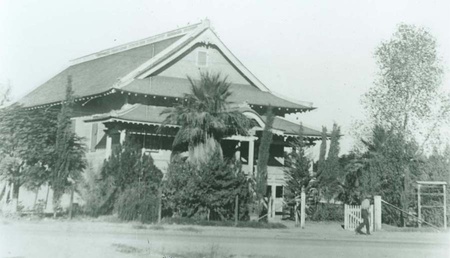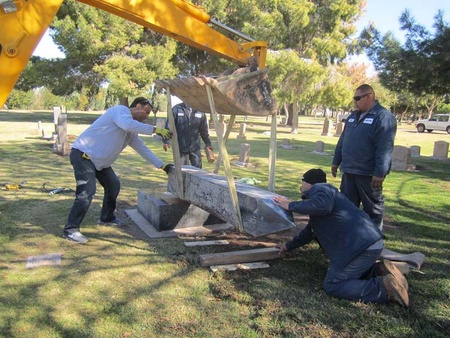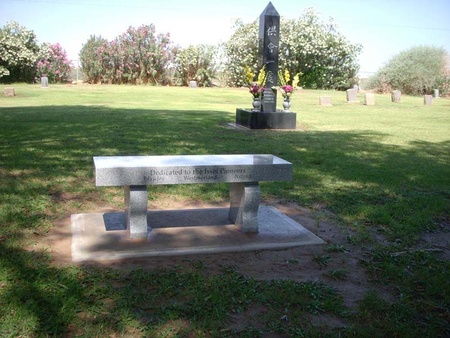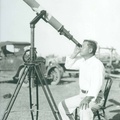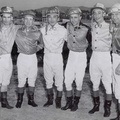Shake & Bake—that is how we characterize the Imperial Valley. The temperature was almost 110 degrees on the afternoon of August 26, 2012, when a magnitude 5.5 earthquake struck. It was centered just a mile or two north of Brawley. Riverview Cemetery is on the northern edge of town and there was severe damage at the cemetery, especially in the northwest corner, which we informally call the “Japanese section.” The earthquake knocked over at least seven headstones bearing Nikkei names, and I was shocked that it caused the Buddhist Memorial Monument (Ireihi) to topple over. Seeing the tall obelisk lying on the ground gave me the most unsettling feeling. It is hard to describe, but I think it was mostly sadness and a touch of eeriness. I started a fundraising drive to repair the monument and what evolved was an 8-month beautification project that included the installation of a bench and the planting of a shade tree.
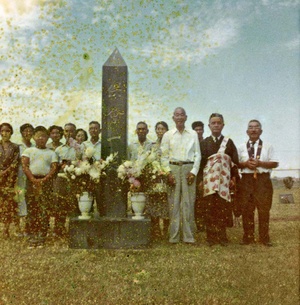
Left to right: Kana Uyechi, Mine Imai, Jun Masuoka, Fujiko Tsujimura, Chosuke Baba, unidentified, unidentified, Ryohei Tsujimura, Eda Asamen, Zentaro Asamen, Tatsuo Asamen, Rimban Masuoka, and Tsuchizo Yamaguchi.
The Ireihi had been erected in 1960 to memorialize the former Brawley Buddhist Church (Bukkyōkai). The Bukkyōkai in Brawley was first organized in 1922 as a branch of the Los Angeles Hompa Hongwanji Temple and services were held at various locations around town, including Nakamura’s Boarding House. The Brawley Buddhist Church achieved its independent status in 1927 and a temple building was constructed at 333 South 8th Street. The Hondō (Worship Hall) was the only example of Japanese architectural design in the Imperial Valley. The church also established a Japanese language school, which in its heyday boasted six teachers and 120 students and even had its own school bus! In addition to the Fujinkai (Women’s Auxiliary), church organizations included the Lotus Club for young ladies and a Junior Young Buddhist Association for both men and women, which sponsored monthly dinners and an annual speech contest.
Following the Pearl Harbor attack, local Nikkei families stored their belongings in the temple before being forcibly removed to the Poston concentration camp. During the war, the building was ransacked and vandalized. After the war, so few of the Sangha (church membership) returned that it was not possible to reestablish the Brawley Bukkyōkai. Moreover, in the face of persistent hostility, Japanese Americans in the Imperial Valley were advised by local War Relocation Authority officials to lie low, not to congregate, and not to draw attention to themselves.
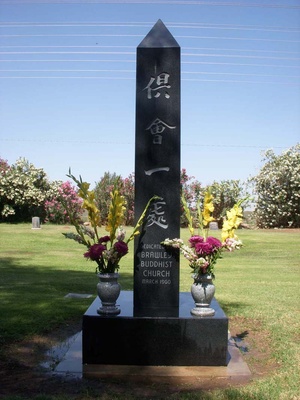
The inscription comes from a line in the Amida Kyo Sutra and may be interpreted as looking forward to being reunited with our departed loved ones in the Pure Land.
After enough time had passed, Nikkei families in Brawley, Westmorland, and the surrounding area resolved to commemorate their once vibrant Buddhist church by erecting an 8-foot monument at Riverview Cemetery. Renowned as a master calligrapher and orator, Reverend Ryuei Masuoka was approached to write the sacred KU E ISSHŌ inscription for the ireihi. He had been the last resident minister of the Brawley Buddhist Church (1939-1942) and was subsequently elevated to Rimban of the Hompa Hongwanji Betsuin in Los Angeles (1962-1976). Incidentally, the Bestuin later housed the Japanese American National Museum. Buddhist observances in Brawley resumed with biannual visits of the resident minister from the Buddhist Temple of San Diego. To this day, memorial services are officiated before the Ireihi on Saturday morning of Memorial Day weekend. Services are also held at Mt. View Cemetery in Calexico and Evergreen Cemetery in El Centro.
Repairs to the memorial monument began in 2013. First the obelisk had to be raised and remounted to the base, then the entire monument was polished, and new flower vases were added. The work was done by a monument maker who inspected the damage and discovered that the obelisk had been pinned to the base and that cement was used as the adhesive, which was the standard practice at the time that it was constructed. Cold weather causes cement to crack and it eventually wore away. The pin could have been partially damaged—or was possibly broken all the way through—by the magnitude 7.2 earthquake that struck Calexico on Easter Sunday in 2010. Then the obelisk toppled over during the 5.5 earthquake two years later. The monument maker inserted a new pin adhered with a state-of-the-art epoxy. The chips and scratches caused by the earthquake could not be fixed but they give the Ireihi a historical quality. Nonetheless, the refurbishment does give the monument a brand-new sheen. The old, broken marble flower vases were replaced with more durable granite ones, which were also pinned into place (the original vases were not pinned).
A bench was installed in the shade of a tree nearest the Ireihi. As an expression of deep gratitude to our forebears, the bench is dedicated to all of the Issei pioneers of Brawley, Westmorland, and Niland, regardless of religious affiliation. In addition, all of the individual headstones that fell over during the earthquake were set upright by the cemetery groundskeepers. The area looks respectable once again.
The final component of the beautification project was the planting of a Desert Aspen tree along the roadway where visitors to the “Japanese section” park their cars. In the Imperial Valley nothing is more important than shade. As the tree grows bigger in the years to come, visitors will be able to park in the shade that it provides. This will be especially welcome for the Memorial Day weekend service, when it is not uncommon for the temperature to exceed 100 degrees.
All of these objectives were made possible by generous contributors, most of whom were former members of the Brawley Bukkyokai or their descendants. Interestingly, among the donors were the children of three of the Brawley Buddhist Church’s resident ministers: Reverend Taiyu Tominaga (1931-1934), Reverend Koyo Tamanaha (1937-1939), and Rimban Ryuei Masuoka (1939-1942). It is gratifying to all of us who supported the beautification project that the little bit that we did will memorialize the Issei and Nisei generations’ immense faith and devotion and their fortitude and resilience. Upon completion of the beautification project in May 2013, surplus funds were donated to the Buddhist Temple of San Diego and the Japanese American Gallery in the Imperial Valley Pioneers Museum.
*This article was originially published in the Teikoku Heigen News: Newsletter of the Japanese American Gallery (Winter 2015, Number 29).
© 2015 Tim Asamen


